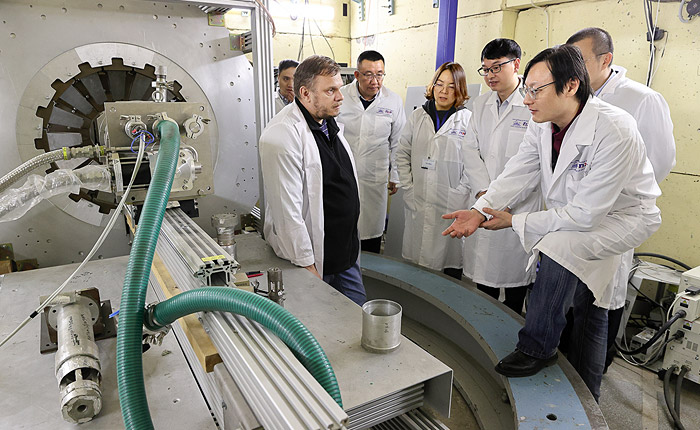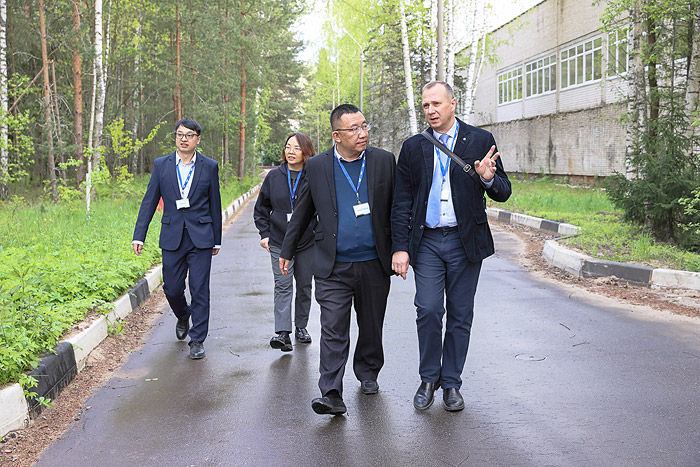
Electronic english version since 2022 |
The newspaper was founded in November 1957
| |
Meridians of cooperation
FLNP and CSNS: there is a topic for cooperation
On 13-15 May, a workshop on neutron scattering technologies and interdisciplinary research was held in Dubna. The meeting was organized by FLNP JINR and CSNS of the Institute of High Energy Physics (China).
Opening the meeting, JINR Vice-Director Latchesar Kostov highlighted that after the signing of a protocol a year ago between the Chinese Academy of Sciences, the Ministry of Science and Technology of China, the Ministry of Science and Higher Education of the Russian Federation and JINR, cooperation has been successfully developing. It is of strategic significance. Important projects are implemented jointly by FLNP and CSNS. He expressed hope that the first workshop would become traditional and wished the participants successful work and fruitful discussions.
Deputy Director of CSNS Liang Tianjiao pointed out the similarity of IBR-2 and the Chinese evaporative source, as well as common scientific interests. IBR-2 has been operating for more than 40 years, allowing good research to be implemented in neutron scattering and other areas. CSNS was launched in 2018 and small-angle neutron scattering is one of the research areas carried out there. "I think our cooperation will be useful for both sides, thanks to colleagues from FLNP for organizing this meeting," he concluded his speech.

Welcoming the guests from China, FLNP Director Egor Lychagin mentioned, "We are united by a large project between FLNP and CSNS and the two neutron sources themselves have a lot in common." And the sources, their experimental environment, research areas, user programmes and future projects were presented in the reports of FLNP Director and CSNS Deputy Director, that were the first reports of the meeting.

Before the excursion to IBR-2. Liang Tianjiao and Egor Lychagin are discussing similar issues of the facilities
"The history of this meeting is as follows," Egor Lychagin answered my question. "Chinese colleagues showed interest in cooperation at one time and came to Dubna eight years ago and took part in our international ISINN seminar. These were mainly specialists in the field of nuclear physics. Later, they built quite a lot of neutron scattering facilities at their source and at some point, when an agreement was signed between JINR and the Chinese Academy of Sciences, the issue about joint projects between JINR and Chinese Institutes arose. Surely, a project arose between FLNP and CSNS, since our sources have many similar parameters and similar methodological and technical challenges arise; nearly the same science is studied on them. Therefore, such a project was supported by a group of experts from JINR and China. Today, the Chinese side waits for funding from its government, but even earlier, we decided to hold a working meeting to determine what issues we will cooperate on, whether it will be joint work on some kind of detector, some kind of electronic devices, calculations of new instruments, others. We invited experts, unfortunately, not all of them were able to come for various reasons; out of 12, only 8 came. Today and tomorrow, we will tell them what we are engaged in on the reactor; from the reports of our Chinese colleagues, we will learn what they are engaged in, what tools and equipment they have. We will show them our experimental facilities and at a round table we will discuss what specific cases we could do together."
Will these be joint experiments?
- For now, we think that it will be cooperation in methodology and technology. In science, both our source and the Chinese source are user tools and we can submit proposals for experiments to each other and over the past year and a half, our scientists have already completed six experiments in China. The goal of this cooperation is to jointly develop technology, to increase the efficiency of their facilities and since the facilities are similar, they can use the best solutions and jointly meet occurring technical challenges.
Along with experts, young Chinese scientists participate in the meeting. Are undergraduate and graduate students expected to be invited to prepare their theses?
- We have not yet envisaged any special youth exchange programme. I think that if business cooperation begins, people will certainly exchange experiences. I saw that the staff working on the Chinese source CSNS is quite young.
Will this meeting become traditional?
- We'll see. Many Chinese colleagues wrote "First working meeting" on the slides of their reports that probably implies that there will be a second one. In fact, if the project starts to be successfully implemented, we will need to meet from time to time to coordinate our positions, to discuss joint issues. It also depends on how we organize the work: will we do something similar independently and exchange results or will we start doing something together and these are different degrees of cooperation. I hope that they will happen from time to time.
I ask Professor Liang Tianjiao to summarize the two days of the meeting:
- Based on the reports given on both sides, we can say that we have common ground. CSNS has a neutron diffractometer and we have developed neutron scattering techniques for diffractometers, refractometers, small-angle neutron scattering instruments and many others. It is also possible to develop related methods - from detector technology to neutron optics, neutron physics. In fact, there is something else that needs to be discussed: the technologies concerning the neutron source, especially the cold moderator.
Of course, common ground should be discussed in detail. Good relationships have been developed between the scientists of our centres and ideas are exchanged. I think we will find more new topics for cooperation after the final discussion.
Will there be a new project after this meeting?
- We work on it, there are already some outlines, but the details are still worked out, perhaps in a couple of months after the agreement is signed it will be possible to talk about it. We also seek financial support from the Russian Science Foundation and the China Science Foundation.
A source of ultracold neutrons will be developed at the new neutron facility of FLNP. Are there plans to develop such a tool in CSNS as well?
- We currently work on two projects and are going to build an ultracold neutron source. I think we have the opportunity to cooperate in this area. Facilities such as ours are aimed at studying fundamental problems; they require close international cooperation not only with Russia, but also with many countries.
Are you going to hold this meeting regularly?
- It may become an annual event, but we hold many other conferences in China. Maybe it's worth holding it every two years; it should be discussed with colleagues. This meeting is definitely not the last one. I think about expanding cooperation, closer collaboration.
Following the meeting, a Memorandum of Understanding was signed, defining the areas for further cooperation.
Olga TARANTINA,
translation by Diana AL-MAAYTA,
photo by Igor LAPENKO